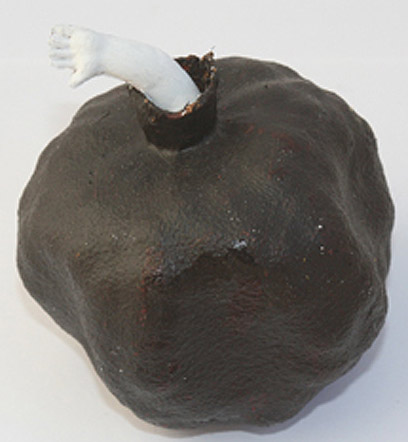
Rabbinic midrashim through artistic expression
Students at Schechter Institute of Jewish Studies in Jerusalem transform rabbinic midrashim into works of art. In the words of one lecturer: 'I wanted Torah study to be not only an intellectual exercise but also to include an experiential facet'
The students' works are being displayed at an exhibition at the Schechter Institute which opened last week, entitled "a Hand-Made Midrash." Twelve students participated in the exhibition, which was organized under the supervision of Dr. Jo Milgrom, a lecturer in the Judaism and the Arts track at Schechter.
One student, Roni Gur, exhibited several works, including a sculpture of a black pomegranate with a small plastic hand extending out of it. Gur writes that this work was inspired by a midrash from tractate Niddah describing the fetus' development: "What was closed was opened (the respiratory system) and what was open was closed (the blood system) for otherwise it would not be able to exist for even one hour." Gur explains:
Giving birth is painful both physically and emotionally. It entails conflicts such as separation and union, beginning and ending, sadness and joy, commencement and closure. The pomegranate is a fruit that symbolizes fertility; its shape and color are reminiscent of a woman's womb. In this work, the pomegranate is black since it concludes its role during the birth process. The little hand is white symbolizing the fetus which is possibly alive and possibly dead. It is unclear whether or not the fetus wants to go out. The aperture of the pomegranate resembles the umbilical cord; it symbolizes the connection between the fetus and the mother, which now must be cut.

Roni Gur's work (Photo: Yafit Galpaz)
In another work entitled AbMa, Gur is photographed with her hands up and her legs spread somewhat so that her body forms the Hebrew letter Aleph. Ab is written on her right side and Ma on her left thus creating the word AbMa (a synthesis of the Hebrew “Abba-Ima”- mother-father).
Gur explains that this work relates to a midrash from tractate Kiddushin: "A person has three partners: The Holy One, blessed be He, his father and his mother." In other words, the parents are partners in creating a person's physical body while God provides the spirit and soul. Gur continues: "A person's body resembles the Hebrew letter Aleph, especially when praying to God. The two feet are planted on the ground and the two hands are extended upwards towards heaven. The corporeal and spiritual are linked through prayer and the work links the three.
Study Torah with feeling
Another work displayed in the exhibition is a mezuzah fashioned like a pad with a quill for writing. It is entitled "and you shall write them on the doorpost of your houses" and was created by Dr. Tamar Kadari.
In her explanation, Kadari writes: "the threshold of the home connects the inside and outside, the above and below, and the mezuzah symbolizes the link between the worlds expressed by the writing on the doorpost. The writing on the mezuzah expresses the human act. Writing in black letters redefines the parchment and the white background represents the spiritual reality. Notes written in the pad depict family situations but can also describe the feelings between a person and God.
Other works in the exhibition present various ideas. One work describes the expulsion from the Garden of Eden to the modern world, another focuses on the creation of the world and light, and so forth.
Schechter lecturer, Dr. Jo Milgrom, says that she believes that art does not have to be beautiful but rather significant and make a statement. She relates that she first thought of the idea of creating art according to midrashim when she received her doctoral degree. She decided that her students would learn in a different way that she had: "I wanted Torah study to be more than an intellectual exercise from the neck up, rather, it should include the experiential and emotional aspect."
In a talk with Ynet, Milgrom says: "the midrashim offer another deeper aspect to Bible study and allow every student to connect with texts from his or her point in time. When it is transferred to the sphere of art it affects every person."










